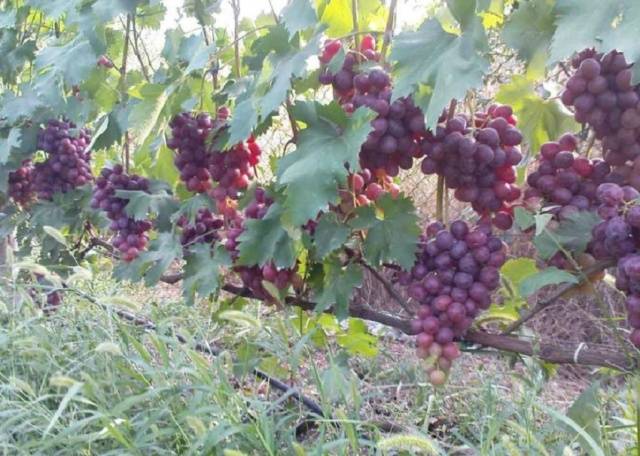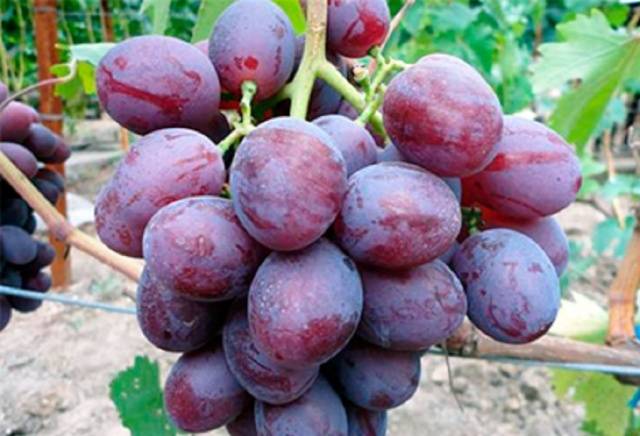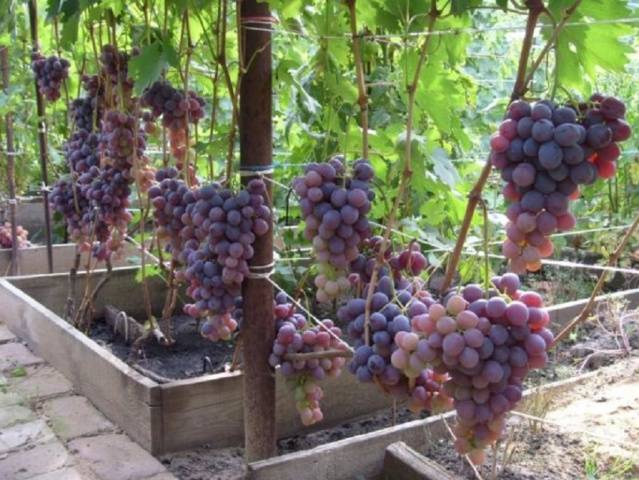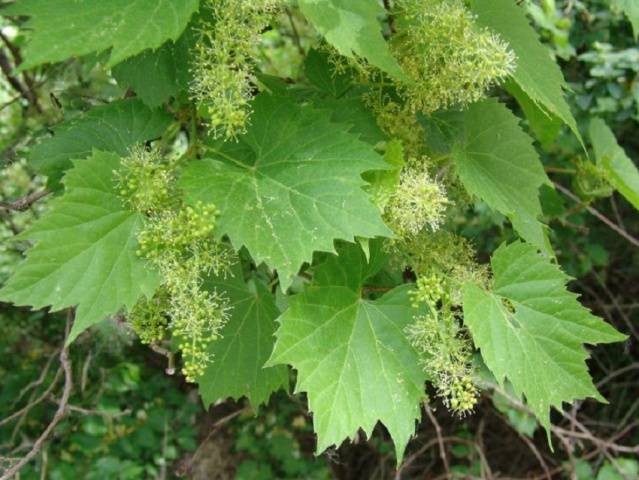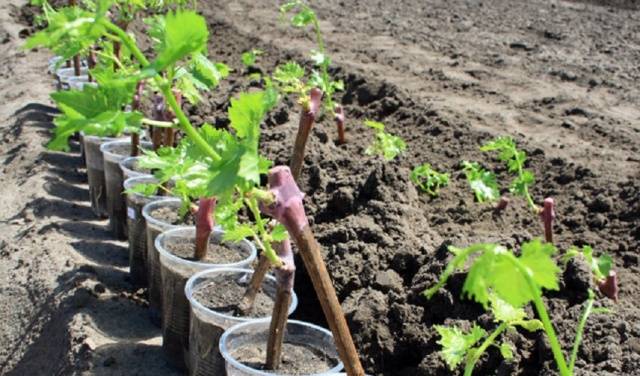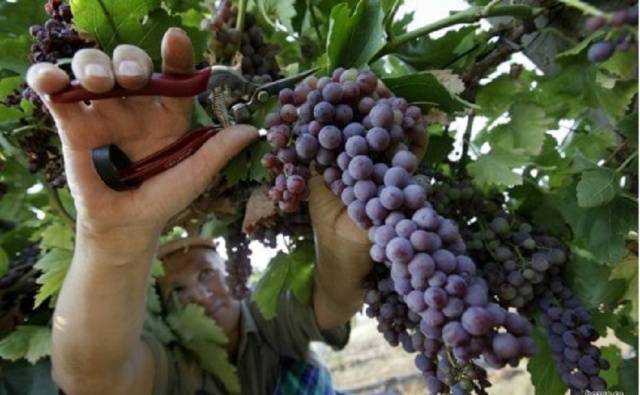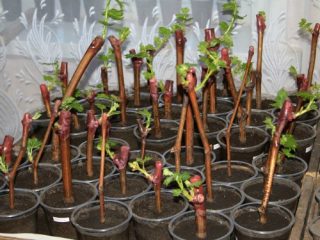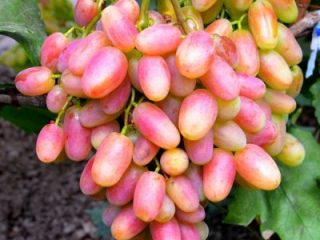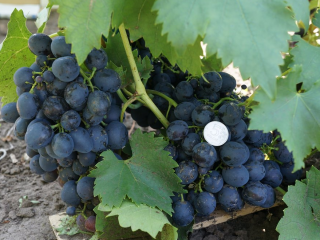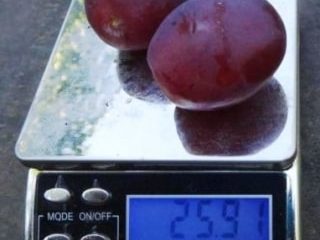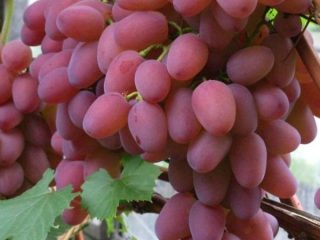Gardeners grow most grape varieties in the southern regions, because they are a heat-loving crop. But winegrowers living in the middle zone also have the opportunity to enjoy delicious berries. For them, amateur breeder N.V. Krainov developed the “Nizina” grape variety. The basis was two well-known types “Talisman” (the second name is “Kesh 1”) and “Kishmish radiata", therefore "Nizina" is considered a hybrid grape variety. To make your acquaintance with the “Nizina” grapes complete, the article will pay attention to the description of the variety, photos and reviews about it, and will also offer a useful video for your reference:
Characteristics of the variety
The main parameters that winegrowers pay attention to first of all are the berries and clusters of the selected variety. The description of the “Nizina” grape variety and the posted photos indicate the data obtained with proper care.
The average weight of a brush is 700 g, although experienced winegrowers claim a record weight of 1.7 kg to 3 kg.
The density of the bunch is average or moderate. According to tasters, the fruits of the Nizina grapes have a cherry flavor. The bunches are stored until December in the refrigerator, without losing their presentation and taste. Until the end of the shelf life they remain attractive, juicy and tasty.
The berry of the “Nizina” variety is oval-shaped, narrowed at the bottom and at the same time large.
The diameter of one grape is equal to the size of a five-kopeck coin, which is confirmed by amateur photos of “Nizina” grapes.
The color of the fruit is red-violet or pink-violet. When the sun's rays hit them, they appear to glow from the inside. The color appears 2 weeks before the onset of consumer ripeness, which is how the variety differs from other types of grapes.
Important! Grapes have a richer dark color in fertile soils.
Inside each berry there are 2-3 seeds, the skin is not hard, and is invisible when eaten.
The ripening period is 130 days with a slight variation in both directions. "Nizina" refers to mid-season grape varieties. Harvesting usually occurs in September. At the beginning or in the middle of the month, it depends on the weather conditions of the current year.
Productivity is regular, parameter indicators are high. From one bush the variety produces 6 kg of delicious fruits. And this is provided that the bush taken is not the most mature one, and its care was carried out at no higher than an average level.
Such yield indicators for the “Nizina” variety are obtained due to the peculiarities of the formation of the grape bush. What are they? The bushes grow quickly and at the same time throw out a large number of fruit-bearing branches. In percentage terms, shoots capable of bearing fruit account for up to 80% of the total number of branches. With normal care, 2 clusters are formed on each shoot, each of which consists of at least 30 grapes. The flowers of the variety are bisexual, the process of pollination and fruit set occurs without problems. Therefore, even an inexperienced winegrower can get a good harvest. If the variety is provided with proper, competent care, then in 2 years the first harvest will be ready.
Advantages and disadvantages
Thanks to the detailed description of the “Nizina” grape variety, you can make a list of the advantages of the hybrid:
- cultivation in the regions of the middle zone, and not just in the south;
- high yield due to the growth characteristics of the grape bush;
- regular fruiting and large berry size;
- resistance to transportation and high-quality presentation;
- frost resistance of the vine, which is not damaged even at -23ºС;
- resistance to gray rot, oidium and mildew;
- full ripening of the vine;
- no wasp damage.
“Nizina” also has distinctive external features. The variety has drooping leaves, which give the plant a wilted appearance.
Grape growers are interested in possible difficulties when growing the variety. After all, any culture has its own characteristics. What can be said about the disadvantages of the “Nizina” grapes? More correctly, these nuances should be called features:
- The variety has strict planting requirements. Each grape bush must have a large feeding area, so plants need to be planted at a considerable distance.
- A large amount of potential harvest that is formed on a bush must be rationed. If you leave it all, the size of the berries and bunches will be much smaller than indicated in the description. Therefore, not only part of the grape harvest is removed, but also part of the shoots.
- With prolonged heat, the variety's resistance to the fungal disease oidium decreases. To avoid this, it is necessary to pollinate the “Nizina” bushes at the stage of fruit filling with dispersed sulfur.
Let’s add to the description of the variety a photo of the “Nizina” grapes and a video about the characteristics:
Now let’s move on to describing the correct process of planting “Nizina” grapes, so that the plant receives comfortable conditions for development from the first days of life.
Landing
First of all, choose a place for grape seedlings. It should be sunny, because lack of lighting leads to poor development of “Nizina” bushes and poor quality of berries. The second requirement is the absence of winds in the selected area. Grape inflorescences are highly sensitive to gusts of wind.
The ideal option would be protection with the help of a structure. Plant grape bushes on the south side of the house, outbuilding or gazebo.
Experienced winegrowers advise paying special attention to fertilizing the soil, as well as preparing the planting hole for “Nizina”.
For grapes to bear fruit well:
- Choose the most suitable place to plant the variety.
- Check the presence and depth of groundwater. If the depth is less than 2 m, this can lead to rotting of the roots. A drainage hole will help correct the situation.
- Add compost to the soil in the fall. In this case, the nutrients will have time to saturate the soil before planting the grapes. When planting in autumn, add fertilizer to the hole 2-3 weeks before the appointed time.
- Dig a planting hole, the depth and width of which should be at least 0.7 m. Place fertilizer - a bucket of organic matter. It is good to add 0.5 kg of superphosphate to the compost. Leave the distance between pits at least 3 m, and between rows at least 4 m.
Inspect the "Nizina" grape seedlings. They should have light roots and a green cut. Before planting, place the roots of the seedlings in the Humate solution.At this time, pour a bucket of water into the middle of the hole and lower the plant into the hole. Immersion depth – to the level of the root collar. At the moment of filling the hole with earth, install a support for the “Nizina” grape seedling. This technique will allow you to easily cover a young bush for the winter. After filling the soil, compact it and water the grapes again.
Video about proper planting of “Nizina” grapes:
Vine care
Watering is very important for “Nizina” grapes. The amount of moisture must be sufficient, otherwise the yield of the variety will significantly decrease. Particular attention must be paid to grape bushes during the dry season. To retain moisture, be sure to mulch the area around the trunk after watering. “Nizina” grapes are watered abundantly at the beginning of the growing season and at the stage of harvest formation. The variety also requires moisture-recharging autumn watering, which contributes to the formation of next year’s harvest and saves the bushes from freezing.
The second important point of care is feeding. In early spring, superphosphate is added to the circles around the trunk at a rate of 40 g per 1 square meter. m. In May, the variety needs nitrogen to grow green mass. As soon as the buds swell, the plants are watered with an infusion of chicken manure. To prepare it, take water with droppings in a 2:1 ratio and leave for a week. Then dilute it again with water 1:10 and water each bush, using 1 liter of solution. At the stage of fruit ripening, potassium fertilizers are used according to the instructions. They will help the grapes in the synthesis of plant sugar. Each fertilizing is combined with watering and applied strictly at the root.
Plants are regularly sprayed as a preventive measure against diseases and pests. Antrakol works well in spring and autumn.
The “Nizina” grapes are pruned annually.A multi-armed fan form is suitable for this variety. It causes less damage to the bush. The shoots are shortened either by 2-4 eyes or by 8-10 eyes each. Also, during the fruiting period, the number of clusters on the bush is normalized.
Shelter for the winter is necessary for seedlings. Powerful mature bushes can withstand low temperatures, but in harsh winters it is better to prevent the vine from freezing. The “Nizina” variety is propagated by cuttings, seedlings and grafting.
Reviews
In order for the description of the “Nizina” grape variety to be complete, in addition to photos, you should add reviews from winegrowers.
